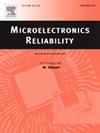Reliability and failure analysis of AlGaN/GaN HEMT with NiPtAu and PtAu gate
IF 1.9
4区 工程技术
Q3 ENGINEERING, ELECTRICAL & ELECTRONIC
引用次数: 0
Abstract
By comparing the reliability of 150 nm AlGaN/GaN HEMTs with PtAu gates to devices with NiPtAu SiN assisted gates, it was found that PtAu gates are more stable in terms of gate leakage current increase under HTRB step stress test and show smaller spread of the extrapolated lifetime values during long-term DC stress tests. An activation energy of 1.39 eV (1.97 eV) and a lifetime of around 107 h at Tch = 175 °C and Vd = 30 V has been extrapolated for devices with PtAu (NiPtAu) SiN assisted gate. By TEM cross sectioning and EDX mapping analysis of aged devices, the degradation of NiPtAu gate devices was attributed to a stress-induced local oxidation of the SiN passivation on the drain side of the gate foot. An activation energy of 1.15 eV and a lifetime of 5 · 104 h at Tch = 175 °C and Vd = 15 V has been extrapolated for devices with 100 nm T-gate reference technology. The faster degradation of the T-gate is possibly caused by a higher lateral electric field at the gate foot. T-gate reference technology lifetime is increased by more than an order of magnitude by reducing the drain voltage to 10 V.
带NiPtAu和PtAu栅极的AlGaN/GaN HEMT的可靠性和失效分析
通过对比150 nm带PtAu栅极的AlGaN/GaN hemt与nippu - SiN辅助栅极器件的可靠性,发现PtAu栅极在HTRB阶次应力测试中栅极漏电流增加更稳定,且在长期直流应力测试中外推寿命值的分布更小。在Tch = 175℃,Vd = 30 V条件下,PtAu (NiPtAu) SiN辅助栅极器件的活化能为1.39 eV (1.97 eV),寿命约为107 h。通过老化器件的TEM横截面和EDX绘图分析,NiPtAu栅极器件的退化归因于应力诱导的栅极脚漏极侧SiN钝化的局部氧化。在Tch = 175°C和Vd = 15 V条件下,采用100 nm t栅参考技术的器件的活化能为1.15 eV,寿命为5.104 h。t型栅的快速退化可能是由于栅脚处的侧向电场较大所致。通过将漏极电压降低到10 V, t栅极参考技术寿命增加了一个数量级以上。
本文章由计算机程序翻译,如有差异,请以英文原文为准。
求助全文
约1分钟内获得全文
求助全文
来源期刊

Microelectronics Reliability
工程技术-工程:电子与电气
CiteScore
3.30
自引率
12.50%
发文量
342
审稿时长
68 days
期刊介绍:
Microelectronics Reliability, is dedicated to disseminating the latest research results and related information on the reliability of microelectronic devices, circuits and systems, from materials, process and manufacturing, to design, testing and operation. The coverage of the journal includes the following topics: measurement, understanding and analysis; evaluation and prediction; modelling and simulation; methodologies and mitigation. Papers which combine reliability with other important areas of microelectronics engineering, such as design, fabrication, integration, testing, and field operation will also be welcome, and practical papers reporting case studies in the field and specific application domains are particularly encouraged.
Most accepted papers will be published as Research Papers, describing significant advances and completed work. Papers reviewing important developing topics of general interest may be accepted for publication as Review Papers. Urgent communications of a more preliminary nature and short reports on completed practical work of current interest may be considered for publication as Research Notes. All contributions are subject to peer review by leading experts in the field.
 求助内容:
求助内容: 应助结果提醒方式:
应助结果提醒方式:


